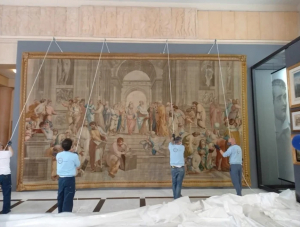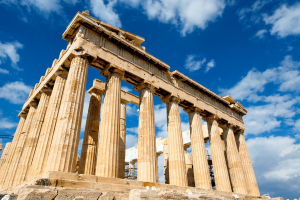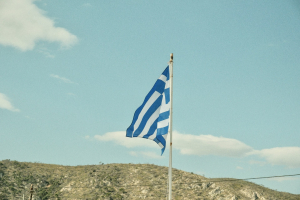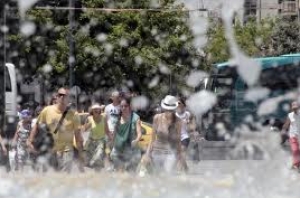BUSINESS CENTRE
XpatAthens
Princeton Establishes A Center For Scholars In Athens
Greece To Witness The Biggest Heatwave Of The Decade
Orange Alert has been issued on extreme weather phenomena, warning of rising temperatures that can locally reach extreme levels.
Thursday, June 29: 40°-41° C
Friday, July 30: 42°
Temperatures will start to drop on Monday.
Perfect opportunity to visit any of these 6 Organized Beaches In Athens or Top 10 Beaches On The Athens Coast!
The Onassis Foundation Awards Two Students From Sepolia The 'One Of A Kind' Scholarship
Watch the animated video HERE and take a journey into the world of this "one of a kind" scholarship!
Greek Semolina Halva
Serves: 8-10
Difficulty: Intermediate
- 3/4 cups sunflower oil
- 1 cup coarse semolina
- 1 cup fine semolina
- 3 cups granulated brown sugar
- 4 cups water
- Zest of 3 oranges
- 1 teaspoon ground cinnamon
- 1/4 teaspoon ground cloves
- 1 teaspoon vanilla extract
- 150 g almond slivers
2. Toast the almond slivers in a shallow baking pan lined with parchment paper for 5-8 minutes.
3. In a non-stick pot saute the vegetable oil with the fine semolina and coarse semolina, over medium-low heat.
4. Stir the mixture continuously for about 4-5 minutes, until the semolina becomes golden brown. Do not rush this process since semolina burns easily. Sauteeing the semolina gives it a rich and nutty flavor.
5. When ready, add the sugar, water, orange zest, cinnamon, and cloves.
6. Stir for another 10 minutes until the mixture thickens and starts to bubble. You will know it is ready when it starts to pull away from the bottom of the pan.
7. Add the almonds and continue to stir.
8. Transfer the mixture into a 22 cm bundt cake pan, hit the cake pan on a hard surface to make sure the mixture settles and your halva is nice and compact.
9. Turn it over after 5 minutes.
Find this and other great recipes on: akispetretzikis.com
Famous Tapestry Adorns The Greek Parliament
The masterpiece has adorned the French National Assembly since 1879 and arrived in our country as a gift from the French Republic to Greece on the occasion of the 200th anniversary of the Greek Revolution.
To read this article in full, please visit: greekreporter.com
Photo credit: AMNA
Daily Life In Ancient Greece: What It Was Like To Live In Athens & Sparta
Despite the fact that they shared the same heritage and language, ancient Athens and Sparta were wildly different with clashing lifestyles, cultures, and values.
Often, the two city-states were not on the friendliest of terms.
The Spartans were warriors, disciplined and strong, and always ready to die for their homeland—hence the word “Spartan,” which is also used today, meaning someone who lives an austere life and is indifferent to pleasures and luxuries.
Athenians, on the other hand, were educated, and those who were not soldiers were philosophers, politicians, writers of tragedies and comedies, musicians, and sculptors.
Growing up in Sparta: a life of self-denial
Life in Sparta was one of simplicity and self-denial. Children were children of the state more than of their parents. They were raised to be soldiers, loyal to the state, strong and self-disciplined.
When a Spartan baby was born, soldiers came to the house and examined it carefully to determine its strength. They bathed the baby in wine rather than water to see its reaction.
If a baby was weak, the Spartans would throw it off a cliff (the Kaiadas) or take it away to become a slave (helot).
Life in ancient Athens was different than in the rest of Greece
Men were the only people considered citizens, so they were frequently seen around the town conducting their business along with slaves.
Men went to the market, met with friends to discuss politics, and went to temples to worship. Interestingly, it was men who did all the shopping and errands outside of the house. Athenian men had a special room in the house just for themselves. This room was for lounging around and entertaining male guests; no women except for slaves and entertainers were allowed inside this room. Contrary to Spartan men, the educated, well-to-do Athenians were very much interested in the arts, philosophy, and aesthetics.
To read this article in full, please visit: greekreporter.com
New Building Remains In Western Peloponnese Point To Poseidon’s Temple
The excavations completed at the end of September revealed part of the foundation of a large building, 9.40 meters wide, the walls of which are 0.80 meters wide. A dense layer of tiles was found inside. Based on the indications of the geophysical survey and the excavation data, the building was at least 28 meters in length, it had two inner rooms, as well as a “pronaos” and a back building or inner sanctum.
Archaeologists believe the elongated temple-shaped building probably belonged to the sanctuary of Poseidon and may even be the temple itself.
The site of Kleidi, where the ancient building was found, had been suggested by earlier researchers as a possible location of the famous ancient sanctuary, as it is situated in the foothills of the ancient acropolis of Samiko, with a command of the area north of the Lake Kaiafa, on the west coast of the Peloponnese.
According to information provided by Greek geographer, philosopher, and historian Strabo in his Geography, Book 8, the sanctuary of Poseidon was an important cult center of the Amphictyonic league (an association of neighboring city-states in ancient Greece to defend a common religious center) of the cities of Triphylia and was situated near the sea, under the acropolis of Samiko.
Combined with the Laconian style of tiling, the discovery of part of the marble water basin (perrirhanterion) leads archaeologists to tentatively date the building to the Archaic period.
The discovery, which is the result of this year’s first excavation season of the five-year research program (2022-2026), is aiming to investigate the topography of the area and identify the sanctuary of Poseidon and the port of Samiko. It is a collaboration between the Ephorate of Antiquities of Ilia headed by Dr. Erofili Kollia and the Austrian Archaeological Institute of the Austrian Academy of Sciences, headed by Dr. Birgitta Eder.
Originally published on: ekathimerini.com
Immigration & Legal Support in Greece
Immigration & Residency Procedures
Greek Tax Registration & Financial Setup
-
Issuing a Greek Tax Identification Number (AFM)
-
Setting up TaxisNet credentials
-
Transferring tax files to the correct local office (DOY)
-
Opening a Greek bank account
-
Registering for AMKA or AMA numbers
-
Enrolling with EFKA (social security)
-
Scheduling and coordinating necessary appointments
-
Entry visa preparation
-
Applications for residence and work permits
-
Renewal processing or changes in legal status
-
Vehicle registration
-
Conversion of EU driver’s licenses to Greek licenses
-
General assistance with legal paperwork
Sweating in the City
The heat is on. This is, clearly, an understatement. The temperatures of the last week have made the topic of ‘the weather’, so common in rainy northern climates, the topic of the day across the city. Have we finally joined the rest of the world who complain about the weather on a daily basis? Hopefully not. But one could be forgiven for doing so this week…
With air conditioners taxed to their maximum, and fans spinning out of control, the midsummer ‘get out of Athens’ feeling is creeping up… For those of us still in the city (and there are many of us these days!), the question is how to enjoy our days and nights while dealing with this heat. For me, the question has become ‘who is arriving or departing today?’ – as I deal with an influx of friends and travelers at my place.
Moving into the city centre has meant that I’m now the preferred destination for friends visiting Athens. I’ve been lucky (!) to have a series of visitors in town for the past month or so. I’ve got my city tour down pat – Plaka, Monastiraki, Acropolis (entrance fee not included), Syntagma, Kolonaki, Exarheia. And even a trip down to the seaside for those who have the time. Nights out in Gazi, in Plaka, at Plateia Karitsi, etc are also included in Jack’s Athens Package. I love to show people my Athens.
The trouble is, they love it here. And they inevitably tell their friends, who also jump on a plane headed for Athens. And before you know it, you have a house full of people with cameras in hand, who can’t wait to see what they can see. At this point I have sweat through all my t-shirts and most of my sneakers. And we’re only at the end of July. Surely it can’t get any hotter…
In my next life, I will own a bed-and-breakfast. With air conditioning.
Until next week,
Jack.
In this weekly space, keep up with ‘Jack’ as he navigates daily life in Athens… Anecdotes, stories, hits & misses, the good, the bad and, well, the rest…
YooMoo: Fat Free Frozen Yogurt in Glyfada
If you’ve driven by Kyprou street in Glyfada, you may have noticed a rash of double parked cars on a certain block. And if you looked closely, you would see a line forming at a little store. It seems that the advent of a do-it-yourself frozen yogurt bar “YooMoo” in Greece has been a success! What’s not to like? You walk in, you choose your flavors, serve yourself, add toppings, weigh and pay- and then you can either run home or sit in the friendly surroundings. If that’s not enough, consider this- the frozen yogurt is FAT FREE!
How it works: Firstly, choose as many flavours as you like and mix them up as you please. Then go crazy on the toppings - naughty, nice or a mixture of everything! Once you are ready, just weigh your creation at the counter and pay by weight. Let loose and moo!
YOOMOO
KYPROU 51
ESPERIDON SQUARE, GLYFADA
TEL: 210 8985150
Do you have a recommendation or recipe to share? Send it to us at ideas@xpatathens.com!











